Star Citizen Ships Development Document
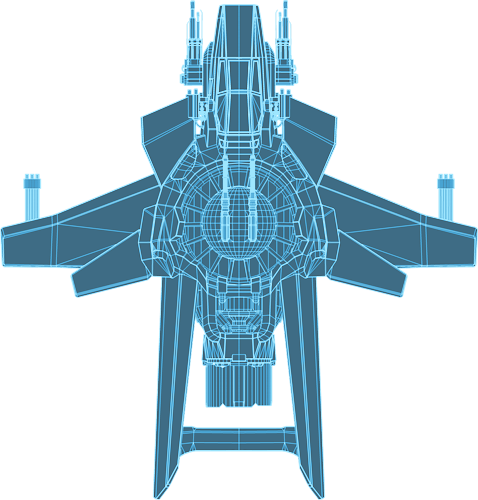
Contents
General Overview
Ships in the Star Citizen universe aren’t just pretty shapes, they are fully functioning vehicles with hundreds of of components, many of which move and articulate as you imagine they would on a real spaceship. Because of this when we design the ships of Star Citizen we have to do more than create something that looks cool, we have to actually think about how the parts of the ship fit together, how they move. If a missile pod or weapon folds into the fuselage we have to make sure there is room for it. We have to worry about the ergonomics of the cockpit, or living quarters inside a bigger ship, how a gantry or a ladder folds out to allow the pilot to climb in, how a door or canopy cantilevers out. In short we have to do industrial design and engineering as much as we do aesthetic design.
This attention to detail extends to things like the engines, the various ship systems; avionics, life support, the various modular upgrade and the weapons.
How Engines Work
All spacecraft performance is based on a linear series of engine components which can be upgraded in thousands of possible combinations. Pilots will treat their engine systems like their PCs, adding modifiers to increase the performance, upgrading the engine as though it were a CPU and even overclocking them (and risking flame-outs!)
INTAKES | MODIFIERS | ENGINE | THRUSTERS
INTAKES are the hydrogen ram scoops on the front of the spacecraft which fuel it by gathering spaceborne hydrogen.. Upgrades alter the effectiveness and the profile of the vehicle; the more effectively a ship takes in fuel the more efficient its engines. The tradeoff is that, unless countermeasures are installed, this also increases the radar signature. The appearance of the ship is altered as well: more primitive intakes look like physical fan blades, others glow different colors as heat capacity increases.
MODIFIERS are a generalized slot for any kind of tech that affects the overall performance of the engine. The list includes engine coolers, exhaust systems, overdrives, afterburners, over clockers and other similar systems. Different ships can have different numbers of modifiers in a chain. The Aurora has a single modifier slot and so a pilot must decide between an afterburner and a cooler… the 300i has two, the pilot has more options.
The ENGINE is the core power plant of the ship. Engine output varies depending on manufacturer, model and type (types include Fission, Fusion, Anti-Matter, etc.) Each selection offers you a different base performance. Engine model examples: General Fusion 3000, Merlin Agena-L, Korolev Atlas III, Suncom Omega.
THRUSTERS are the end of the chain, the physical output point of the engine. They modify the overall engine output: burn at different rates, impact the range, increase or decrease the radar profile of the ship (you might pay extra for “silencer” thrusters which don’t give off such a large drive plume,) etc. Here you will see a significant visual difference: different size nozzles, different colors of thrust, etc. THRUSTERS are defined by two values; its THRUST RATING (TR), which determines the amount thrust it can deliver. The bigger the number, the larger and more powerful the thruster. A 10 rated thruster would be used on a cruiser’s main engines, and a 1 rated thruster would be a maneuvering thruster on a RSI Aurora. You can normally fit a thruster of the same or lower rating but you couldn’t attach a 5 rated thruster to a 3 rated thruster slot. Most ships have a combination of a few higher rated thruster slots for the Main Engine thrust and at least 4, but more usually 8 lower rated thruster slots for the Maneuvering and Retro thrusters. The maneuvering thrusters are used to change the ship’s orientation as well adjust its overall velocity vector. Retro thrusters arrest the ships velocity. Frequently a front mounted maneuvering thruster will also perform retro fire duties.
The second important value for a thruster is its ARTICULATION TYPE; Fixed doesn’t move. The thrusters on the Apollo lunar lander would be classified as fixed. Then there are Jointed thrusters; these are rigid nozzles that can rotate on one or two axis. After this there are Flex thrusters; which can articulate on one or two axis, but aren’t rigid. Think of these like the nozzles on a Harrier or an F-35. Finally there are Vectored thrusters – which have vector flaps that help direct the stream of exhaust.
As an example the Hornet has one 4 rated Vectored Main Engine thruster, four 2 rated flex maneuvering jets (with the front two also performing retro duties) on the top and four 2 rated jointed thrusters on the bottom.
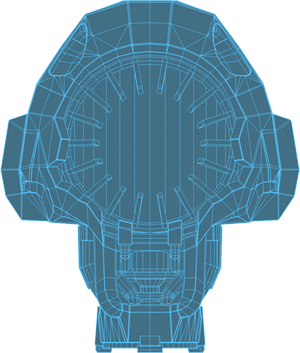
Upgrade Modules
The number and combination of potential upgrade modules is nearly limitless, but some examples include:
Enhanced Cargo Hold -alters your ship’s overall cargo capacity. These come in different flavors: one might give you more room, another might include an electromagnetic barrier that hideS contraband from police scans.
Internal Bulkhead – increases your ship’s capacity for taking damage (available in different materials: plasteel, durasteel, isometa etc.)
Avionics Upgrade – increase your ship’s targeting range, friend or foe identification speed, depth of field, etc. with any number of internal computer hardware updates.
Refinery Tools – larger ships are capable of tractoring in spaceborne junk and asteroids. With a refinery lab aboard your ship you can reduce them to their core components, increasing immediate resale value.
Gun Capacitor – increase the amount of energy your ship can shift from engines to guns at any given time.
Jump Drive – if you’re going to travel from system-to-system, you’ll need a jump drive! Jump drives range from a journeyman model for ordinary pilots to complex explorer models that increase your chances when charting a new star system. Another option is a stealth model which reduces your “jump flash” and makes it easier for you to travel undetected.
Shield Generator – available in a thousand makes and models, each of which can be chained or tuned to a specific pilot’s preferences! Standard shield generators provide X protection at Y recharge for Z energy usage per second. Other models might reflect particular types of guns (ie, a 20% chance of deflecting an energy blast, but weak against physical shot and the like) and still others might impact a ship’s stealth. A strong forward “ramming shield” offers an option to players who want an alternative method of dogfighting…
Note that all of these upgrades also have tradeoffs. The ability to shift more energy to guns also decreases it from engines and shields, an increased cargo hold means that maneuverability or speed is impacted, etc.
Hardpoints
Every ship has hardpoints on which a variety of different weapons can be mounted. Each hardpoint has a classification. A lower classification can always be mounted on a higher classification hardpoint, but not the other way around.
CLASS 1: Fixed Gun. This is your standard forward facing laser, neutron cannon, particle gun, etc.
CLASS 2: Articulated Gun. Think the guns in Freelancer or the smart weapons found in later Wing Commanders. Class 2 hardpoints are rarer and more expensive, but they allow guns to rotate on an arc rather than fire point blank.
CLASS 3: Pylon. This is where you mount missiles, ECM units, radar pods, drop tanks, additional ammunition, special scanners, etc.
CLASS 4: Turret. Uses the same fixed guns as class 1, but mounted in a separate area of the ship which may be crewed by another person. Turret slots can also mount pylon-type weapons (i.e. a tractor beam or a chaff dispenser.)
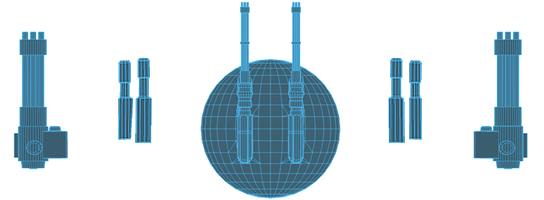
Weapons
Weapon Manufacturers
Behring – Terra-based weapons consortium.
Outsources to a lot of designers and subsidiaries to be a one-stop
shop for all your defensive needs. Think of it as a conglomerate
of Springfield Arms and General Dynamics. They make guns,
missiles, tanks, dropships, sentry drones, etc. mostly for the UEE but
there are civilian models. Usually favor quantity of production
over quality.
Popular models: P4AR – Standard issue rifle for the UEE
military about as basic and recognizable as the modern M16. Also
comes in the P4SC, a more compact and collapsible carbine version.
Klaus & Werner – some government contracts but
mostly personal defense company. Almost exclusively handguns,
rifles, and shotguns (both energy and hard-ammo).
Popular models: Model II Arclight – handheld laser made famous as Kyle Fenris’ sidearm on the hit Vid-Show The Frontier.
Associated Sciences & Development (ASD) –
High-end weapons company. Usually their stuff is very expensive
and exclusive. Mostly energy weapons but also some ‘specialty’
classes. Distortion cannons, rail guns, shredders, etc.
Popular models: Gained notoriety with the unveiling of the EE6
Electron Cannon. The blast would polarize the electrical charges
on an atomic level, causing all sorts of destruction as well as some
ugly, gruesome deaths. Consequently they have a somewhat tarnished
reputation with the public.
Talon Weapon Systems – Croshaw-based munitions manufacturer, focusing mostly on missiles, bombs, and torpedoes. If it exists, there’s a Talon that can blow it up.
Joker Engineering – Small start-up company founded by an eccentric engineering whiz-kid named Barlowe Elias. Burst onto the scene by creating ‘specialty weapons.’ His weapons are generally favored by criminals and pirates because of their unusual applications, such as the Beacon Bomb designed to simulate a distress beacon with customizable distress calls.
Guns
Design Philosophy
Guns are an exception to the “more is better” rule that applies to all other upgrades. Looking back at the original Wing Commander games, there’s a clear jump: you had the original games where there were between three and eight gun types and players had a clear feel for each one and the later games where there were ten to twenty and they all felt light different colors of the same thing. Anyone can tell you which their favorite gun loadout in Wing Commander I or II was (and it will be different for each person) whereas few can tell you which guns the ships in Wing Commander III forward even had.
Like those earlier games, we want to design a few iconic gun types and then build on that canon (pun intended!) over time. Variation can be added with modifiers (gun silencer, gun cooler, over clocker) and different companies or subordinate models of the same weapon (perhaps the ASD Mass Driver is distinctly inferior to the Behring model.) But developing a new gun–say, introducing the first Particle Cannon–should ultimately be treated as a major event in the game world.
Gun Types (at Launch)
Energy Weapons
Behring Mk. V Laser Cannon
Clarkson Industries C44 Electron Gun
A&R Fix-mount Plasma Particle Blaster
Intergalactic Research Concepts Phased-Array Tachyon Cannon (“X-1”)
Ballistic (hard-ammo) Weapons
Klaus & Werner Mass Driver Cannon
ASD PN-21 Scattergun
Behring “Ripper” GaussGun
MaxOx 35mm Dredge Gun (fires AP Sabot rounds)
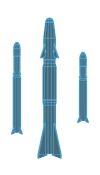
Self-Propelled Weapons
Note that all self propelled weapons are mounted on pylon-based launchers which can be attached to a class 3 or class 4 hardpoint. The same general class of self propelled weapons will be produced by any number of companies and we will encourage player loyalty to “their” brand. Maybe a more expensive ‘name brand’ missile has a little bit more of a kick, versus cheap store brands and even cheaper ‘discount’ missiles that have a higher rate of failure.
Missiles
Missile are defined by three important components;
GUIDANCE | PROPULSION | PAYLOAD
GUIDANCE: this can be Dumb (no target acquisition – this is the behavior of a rocket), Heat Seeking, Image Recognition, Friend or Foe.
PROPULSION; This is normally some form of a thermal jet propellant system; either a solid or liquid propellant. Some larger missiles can however use more exotic forms of propulsion, closer to what a spaceship will use.
PAYLOAD; this can be PBX High Explosive (HE), Nuclear (Fission and Fusion), EMP and Anti-Matter.
Examples of missiles in the Star Citizen / Squadron 42 world are;
Behring Arrow (Dumb/HE) (aka: Lemmings, Matchsticks)
Talon Devastator (Heat Seeking/Variable payload)
Behring Judge (Friend or Foe/HE or AP)
Talon IR4 Stalker (Image Recognition/HE or Anti-Matter)
Behring Mk2 (Friend or Foe/MIRV)
Joker XXV Vampire (aka “Leech”)
Talon Fusion Torpedo (Dumb/Nuclear)
ASD Chaff Auto-Dispenser Countermeasures
Joker XB-44 “TomatoCan” (IR or HS/HE Frag)
ASD BV-8 Blackout (Dumb or IR/EMP)
Talon SV32 Bulkhead Buster
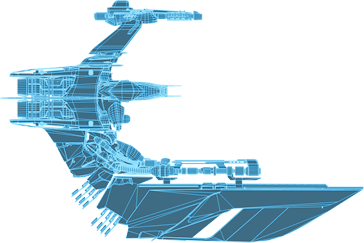
SHIPS
Spacecraft design and construction have become big-business. Like the car industry of the 20th-22nd Century, many companies have tried their hand at building and selling the latest and greatest ships. Here is a list of the major companies still producing today:
Ship Manufacturers
ROBERTS SPACE INDUSTRIES (RSI)
The original creators of the engine that kickstarted humanity’s expansion into space, Roberts Space Industries build a wide range of spaceships that serve all needs starting at basic interstellar travel to deep exploration on the outer edges of the galaxy. The tagline is “Roberts Space Industries: Delivering the Stars since 2075”
ORIGIN JUMPWORKS GmbH
The BMW of the Star CItizen universe. Their craft are more expensive, sleeker looking status symbols, maybe more so than they’re worth? They get numbers instead of names: “Origin 300i,”"Origin 890 Jump,” “Origin M50 Turbo,” etc.
MUSASHI INDUSTRIAL & STARFLIGHT CONCERN (MISC)
Mass produces very efficient, modular ships, mostly armored freighters of different sizes that make them the preferred brand for traders and larger corporations.
DRAKE INTERPLANETARY
Ostensibly a legitimate company, it’s an open secret that they manufacture cheap, well-armed craft favored by pirates, to the point that they’re named in that vein: “Cutlass,” “Buccaneer,” “Privateer,” and “Marauder,” etc.
ANVIL AEROSPACE
Produces dogfighters, but with less of the pirate stigma. These ships are more expensive, less spit-and-glue.

Ship Information
Aurora
Builder: Roberts Space Industries
Crew (max): 1
Mass (empty): 15,000 KG
Focus: Exploration / Light Mercantile
The Aurora is the modern day descendant of the Roberts Space Industries X-7 spacecraft which tested the very first jump engines. Utilitarian to a T, the Aurora is the perfect beginner’s ship: what it lacks in style it makes up for in ample room for upgrade modules. Most pilots move up from an Aurora as quickly as their credit accounts allow… but a select few regard flying this venerable spacecraft as a badge of honor!
Upgrade Capacity: 4
Cargo Capacity: 5 tonnes
Engine-
Modifiers: 1
Max. Class: Fission
Thrusters: 1x TR3, 8x TR1
Hardpoints-
2 x Class 1: Equipped 1 x Behring Fixed M3A Laser Cannon
1 x Class 3: EMPTY
Similar to… Tarsus, Straith, Startracker, Y-Wing
300i
Builder: ORIGIN JUMPWORKS GmbH
Crew (max): 1
Mass (empty): 20000 KG
Focus: Dogfighting / Courier
If you’re going to travel the stars… why not do it in style? The 300i is Origin Jumpworks’ premiere luxury spacecraft is a sleek, silver killer that sends as much of a message with its silhouette as it does with its particle cannons. Some have accused Origin of putting style over substance and inflating the sticker price to match… but at heart the 300i is still an elegant dogfighter’s tool.
Upgrade Capacity: 6
Cargo Capacity: 8 tonnes
Engine-
Modifiers: 2
Max. Class: Fusion
Thrusters: 1x TR4, 12x TR1
Hardpoints-
2 x Class 1: Equipped 2 x A&R “Omnisky III” Laser Cannon
1 x Class 2: None Equipped
2 x Class 3: None Equipped
Similar to… Centurion, Icarus, Falcon, J-327
Hornet
Builder: Anvil Aerospace
Crew (max): 1
Mass (empty): 22,000 Kg
Focus: Dogfighting / Interception
The Hornet is the civilian version of the F7A Hornet flown off of the elite Bengal carrier vanguard of the UEE Navy. While not outfitted for long range runs, the Hornet can take her share of hits… and dish out a consistent, powerful response. The Hornet may be uglier than anything from Origin’s lineup, but pilots love them for their rugged reliability.
Upgrade Capacity: 6
Cargo Capacity: 4 tonnes
Engine-
Modifiers: 2
Max. Class: Fusion
Thrusters: 1 x TR4, 8 x TR2
Hardpoints-
2 x Class 1: Equipped 2 x MaxOx NN-13 Neutron Gun
2 x Class 2: Equipped 2 x Klaus & Werner CF-117 Laser Gatling
2 x Class 3: Equipped 4x Talon Devastator (HS) missiles
2 x Class 4: None Equipped
NOTE: On the military version of the Hornet the two Class 4 hardpoints are utilized by a Ball Turret with twin Laser Gatlings and a Canard Turret with twin Neuton Guns. The Ball Turret takes 4 Upgrade Slots (Its a ball turret or the decnet size cargo cargo hold)
Similar to… F-71 Stiletto, ML3B Freij, Liberty Defender, X-Wing
Freelancer
Builder: MISC (Musashi Industrial & Starflight Concern)
Crew (max): 2
Mass (empty): 55,000 KG
Focus: Long-Range Exploration / Heavy Mercantile
MISC is known for producing efficient, modular, middle-of-the-road ships, primarily transports of
different sizes. Freelancers are used as long haul merchant ships by
major corporations, but they are just as frequently repurposed as
dedicated exploration vessels by independent captains who want to
operate on the fringes of the galaxy. Don’t let some of the alien
technology in the cockpit surprise you: the Freelancer’s design owes
several of its internal systems to a lend-lease deal with the Xi’An.
Upgrade Capacity: 10
Cargo Capacity: 20 tonnes
Engine-
Modifiers: 3
Max. Class: Anti-Matter
Thrusters: 2x TR5, 8 x TR2
Hardpoints-
4 x Class 2: Equipped 2 x Behring M3A Laser Cannon
2 x Class 3: Equipped 2 x Talon Stalker Image Recognition missiles
1 x Class 4: Equipped 1x Behring M5A Laser Cannon (turret)
Similar to… Galaxy, Gea Transit, Humpback, Imperial Shuttle
Constellation
Builder: Roberts Space Industries
Crew (max): 4
Mass (empty): 75,000 kg
Focus: Long-Range Mercantile / Space Superiority
When you think handsome bounty hunter making his own way in a galaxy of enemies, you think the Constellation. The Constellation, a multi-person freighter, is the most popular ship in RSI’s current production array. Constellations are beloved by smugglers and merchants alike because they are modular, high powered… and just downright iconic-looking. The Constellation includes a manned turret, a large cargo area and a small flight deck capable of launching a snub fighter in its own defense.
Upgrade Capacity: 14
Cargo Capacity: 35 tonnes
Engine-
Modifiers: 4
Max. Class: Anti-Matter
Thruster Class: 4 x TR6, 8 x TR3
Hardpoints-
2 x Class 1: Equipped 2 x Behring M3A Laser Cannon
4 x Class 2: Equipped 2 x A&R Pike IV Neutron Gun
6 x Class 3: Equipped 2 x Behring Judge missiles (Friend or Foe)
2 x Class 4: Equipped 1x Behring M5A Laser Cannon (turret)
Tender -
Short Range P52 Space Fighter
Similar to… Paradigm, Salvia, Armored Transport, Millennium Falcon
Cutlass
Builder: Drake Interplanetary
Crew (max): 2
Mass (empty): 35,000 Kg
Focus: “System Defense” (Piracy)
Drake Interplanetary claims that the Cutlass is a low-cost, easy-to-maintain solution for local in-system militia units. The larger-than-average cargo hold, RIO seat and dedicated tractor mount are, the company literature insists, for facilitating search and rescue operations. While it’s true that Cutlasses are used throughout known space for such missions, their prime task and immediate association is with high space piracy. Cutlasses, often operating in groups, menace distant transit lanes to prey on hapless merchants. A single Cutlass can ravage a mid-sized transport and a pack operating as a clan can easily take down larger prey. STOL adaptations allow these interceptors to operate off of modified transports or pocket destroyers; the most common warships that make up pirate caravans.
Upgrade Capacity: 5
Cargo Capacity: 10 tonnes
Engine-
Modifiers: 2
Max. Class: Fusion
Thrusters: 1 x TR4, 16 x TR2
Hardpoints-
2 x Class 1: Equipped 2 x MaxOx NN-13 Neutron Gun
1 x Class 2: Equipped 2 x A&R Mark IVc Tractor Beam
2 x Class 3: Equipped 4x Python Tracer (HS) missiles
2 x Class 4: None Equipped
Caterpillar
Builder: Drake Interplanetary
Crew (max): 5
Mass (empty): 68,000 Kg (heavier due to armor)
Focus: Heavy Mercantile (Pirate)
Drake maintains that the Caterpillar, a sprawling, modular spacecraft which appears at least somewhat like its namesake, is for legitimate commerce and extended search and rescue missions… but at the end of the day, the Caterpillar is truly the evil twin of the Freelancer.
Designed for supporting pirate operations, the Caterpillar features a large cargo hold for carrying loot, heavier armor than other freighters in its class and room for five crew able to serve in boarding operations. Despite its heavier armor, the Caterpillar isn’t a bulldog… a succesful operation will require a fighter escort.
Upgrade Capacity: 8
Cargo Capacity: 20 tonnes
Engine-
Modifiers: 2
Max. Class: Anti-Matter
Thrusters: 2x TR5, 8 x TR2
Hardpoints-
4 x Class 2: Equipped 2 x Behring M2A Laser Cannon
2 x Class 3: Non Equipped
2 x Class 4: Equipped 2x Behring M5A Laser Cannon (turret), 1x L-Sys Mark III Tractor Beam
M50
Builder: ORIGIN JUMPWORKS GmbH
Crew (max): 1
Mass (empty): 14,000 Kg
Focus: Interceptor / Racer
If you want to get from point A to point B as quickly as possible and with as much style as possible then ORIGIN’s M50 is for you. Featuring supercharged engines that counter a tiny weapons loadout, the M50 is a ship for going FAST. The core spaceframe is used by both racing teams and for military courier missions, but the civilian M50 is a luxury spacecraft like no other. Perfect for the mercenary who prefers speed over armor in a dogfight… or the weekend warrior looking to impress the ladies.
Upgrade Capacity: 5
Cargo Capacity: 3 tonnes
Engine-
Modifiers: 3
Max. Class: Fusion
Thrusters: 2 x TR4, 8 x TR2
Hardpoints-
2 x Class 2: Equipped 2 x Kroneg AS-44 Needle Repeater Laser
2 x Class 3: Equipped 2 x Talon Devastator (HS) missiles
Retaliator
Builder: Aegis Dynamics
Crew (max): 6
Mass (empty): 89,000 Kg
Focus: Strategic Bombing
The Retaliator is the United Earth Empire’s premiere, if aging, jump-capable heavy bomber. Massive formations of these spacecraft running long-range strike missions is not an uncommon site around the fringes of the empire. With a distinctive elongated silhouette that is dotted with turrets and carrying a massive bomb load, the Retaliator is an effective symbol of Imperial might. As such, they are the frequent centerpiece of Space Force recruiting posters. Retaliators are ground-based, with all but the largest carriers unable to operate them effectively. Heavily modified Retaliators are becoming commonplace on the civilian market as the design ages and earlier production runs are sold off en-mass. Outfitted to carry cargo instead of antimatter bombs and with the waste turret positions typically swapped for makeshift living quarters, they make a good medium freighter or a basic explorer. Some have even been converted into long-hop passenger spacecraft!
Upgrade Capacity: 8
Cargo Capacity: 30 tonnes (bomb-load)
Engine-
Modifiers: 3
Max. Class: Antimatter
Thrusters: 5 x TR5, 8 x TR2
Hardpoints-
0 x Class 1: n/a
0 x Class 2: n/a
12 x Class 3: Equipped 8x A&R Stryker (FoF)
missiles (maybe a note that the Retaliator can carry anti
capital chip torpedoes?)
5 x Class 4: 8x Behring M5A Laser Cannon (turret) – Ventral (underneath), dorsal (top), tail, left and right beam / waist (side)]






